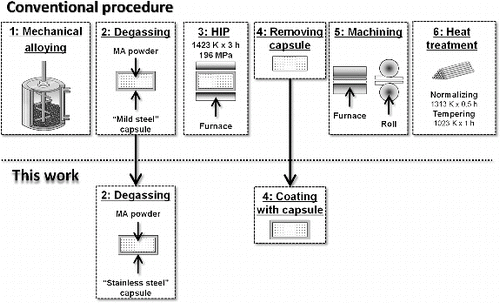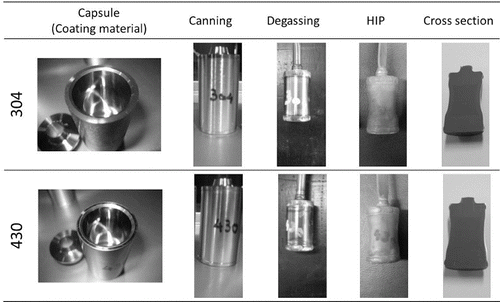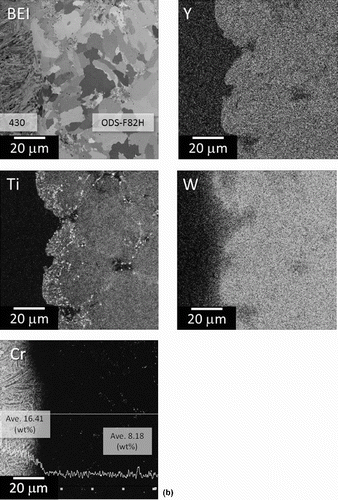Abstract
Oxide-dispersion-strengthened (ODS) steels are attractive materials for application as fuel cladding in fast reactors and first-wall material of fusion blanket. Recent studies have focused more on high-chromium ferritic (12–18 wt% Cr) ODS steels with attractive corrosion resistance properties. However, they have poor material workability, require complicated heat treatments for recrystallization, and possess anisotropic microstructures and mechanical properties. On the other hand, low-chromium ferritic/martensitic (8–9 wt% Cr) ODS steels have no such limitations; nonetheless, they have poor corrosion resistance properties. In our work, we developed a corrosion-resistant coating technique for a low-chromium ferritic/martensitic ODS steel. The ODS steel was coated with the 304 or 430 stainless steel, which has better corrosion resistances than the low-chromium ferritic/martensitic ODS steels. The 304 or 430 stainless steel was coated by changing the canning material from mild steel to stainless steel in the conventional material processing procedure for ODS steels. Microstructural observations and micro-hardness tests proved that the stainless steels were successfully coated without causing a deterioration in the mechanical property of the low-chromium ferritic/martensitic ODS steel.
1. Introduction
Oxide-dispersion-strengthened (ODS) steels have attractive high-temperature mechanical properties and irradiation resistance for application as fuel cladding in fast reactors and first-wall material of fusion blanket. In recent studies, significant focus has been given to high-chromium ferritic (12–18 wt%) ODS steels owing to their attractive corrosion resistances to supercritical pressurized water and lead bismuth used as coolants [Citation1]; however, they have poor material workability and require complicated heat treatments for recrystallization in order to reduce their anisotropic microstructures and mechanical properties. These issues limit their practical application [Citation2–5].
Compared to high-chromium ferritic ODS steels, low-chromium (8–9 wt%) ferritic/martensitic ODS steels have better material workability, because they do not require complicated heat treatments for recrystallization. In addition, their anisotropic microstructures and mechanical properties can be reduced through martensitic transformation during normalizing [Citation6]. However, their corrosion resistances are poorer than those of high-chromium ferritic ODS steels [Citation1]. In our work, a corrosion-resistant coating technique was developed to impart better corrosion resistance to low-chromium ferritic/martensitic ODS steels. In this coating technique, we used the canning material as a coating material through the conventional material processing procedure for ODS steels. In the conventional material processing procedure, the canning material is mild steel and is removed after the consolidation of mechanically alloyed (MA) powder. In our work, this canning material was simply replaced with the 304 or 430 stainless steel, which has better corrosion resistances compared to low-chromium ferritic/martensitic ODS steels. We then assessed the feasibility of this new coating technique through microstructural observations and micro-hardness tests, focusing on the interface between the coating material and the coated low-chromium ODS ferritic/martensitic steel.
2. Experimental
2.1. Coating technique
A schematic illustration of the coating technique is shown in . In this figure, the upper part shows the conventional material processing procedure for ODS steels and the lower part shows the new technique introduced in our study for coating a low-chromium ferritic/martensitic ODS steel with the 304 or 430 stainless steel. The low-chromium ODS ferritic/martensitic steel used is ODS-F82H, which has the highest level of creep property among the low-chromium ferritic/martensitic ODS steels [Citation7]. F82H is one of the reduced-activation ferritic/martensitic steels developed as structural materials for fusion blankets; the latest research and development results are summarized by Tanigawa et al. [Citation8]. shows the analyzed chemical compositions of these materials used in our work. The chemical compositions for the ODS-F82H are obtained by analyzing its MA powder. The compositions for both the stainless steels are obtained by analyzing the canning materials. In the conventional material processing procedure for ODS steels, the canning material used has been mild steel, which is removed after consolidation; however, in our work, this canning material is replaced with stainless steel, which is subsequently used as the corrosion-resistant coating material in order to impart better corrosion resistance to the ODS-F82H. Austenitic stainless steels such as 304 and 316 have better corrosion resistances than those of ferritic stainless steels such as 430 because they contain nickel [Citation9]. However, nickel cannot be used for the fusion blankets in terms of reducing activation. Therefore, the 430 stainless steel was chosen along with the 304 stainless steel as a coating material.
Table 1. Chemical composition (wt%).
2.2. Microstructural observation
The interfaces and the surrounding areas of the ODS-F82H specimens coated with the 304 or 430 stainless steel were observed using a field emission gun-electron probe microanalyzer (JEOL JXA-8530F) in order to study the microstructural developments caused by the newly introduced coating technique. Elemental mapping was performed on chromium, nickel, tungsten, yttrium, and titanium, which are the most significant elements in terms of corrosion resistances and mechanical properties. In particular, line analyses were performed on chromium and nickel to estimate their corrosion resistances.
2.3. Micro-hardness test
The interfaces and the surrounding areas of the ODS-F82H specimens coated with the 304 or 430 stainless steel were tested using an ultra-micro indentation testing system, CSIRO UMIS-2000, to fundamentally study the effect of the new coating technique on mechanical properties of the ODS-F82H. All specimens were indented up to 495 nm from the surface with an indentation load of 15–30 mN.
3. Results and discussion
3.1. Processing procedure
shows the photographs of the samples taken after each step in the processing procedure: canning, degassing, and hot isostatic pressing at a pressure of 196 MPa for three hours at 1423 K in order to consolidate the MA powder. The dimensions of the capsule used are φ25 mm in inner diameter, 5 mm in thickness, and 25 mm in inner height. The cross sections of the consolidated specimens are also shown. There appeared no difficulties due to the change of the canning material, because no clacks were observed on the interfaces. The newly introduced coating technique did not cause any additional difficulties in the material processing of ODS steel.
3.2. Microstructure
shows elemental mapping images of the interfaces and the surrounding areas of the ODS-F82H specimens coated with the 304 or 430 stainless steel. In this figure, the corresponding backscattered electron images (BEIs) are also shown. In (a), no micro-cracks were observed on the interface of the ODS-F82H specimens coated with the 304 stainless steel. Tungsten, yttrium, and titanium, which play important roles in the strengthening mechanism of the high-temperature mechanical property of the ODS-F82H, were not detected in the portion of the 304 stainless steel. However, a few signals of titanium were detected on the interface due to the formation of titanium oxides [Citation10], but this was limited to a narrow region. This result suggests that the switching of the canning material did not lead to a deterioration in the high-temperature mechanical property of the ODS-F82H specimen coated with the 304 stainless steel. The chromium and nickel contents decreased from the portion of the 304 stainless steel to the portion of the ODS-F82H for a distance of approximately 10 μm. However, these contents in the inner portion of the 304 stainless steel were constant. Consequently, the 304 stainless steel coated on the ODS-F82H can have a superior corrosion resistance without any degradations. Similar to the case of the 304 stainless steel, no micro-cracks were observed on the interface of the ODS-F82H specimen coated with the 430 stainless steel, as shown in (b). Tungsten, yttrium, and titanium were not detected in the portion of the 430 stainless steel. However, a few signals of titanium were detected on the interface due to the formation of titanium oxides [Citation10], but this was limited within a narrow region. This result suggests that the switching of the canning material did not lead to a deterioration in the high-temperature mechanical property of the ODS-F82H specimen coated with the 430 stainless steel. The chromium content decreased from the portion of the 430 stainless steel to that of the ODS-F82H for a distance of approximately 10 μm. The chromium content in the inner portion of the 430 stainless steel was constant, although some matrices for the portion of the 430 stainless steel near the interface showed a martensitic structure. Consequently, the 430 stainless steel coated on the ODS-F82H can have a superior corrosion resistance without any degradation. As for the matrices which transformed to a martensitic structure, carbon possibly moved from the ODS-F82H portion to the 430 stainless steel portion during material processing procedures, because carbon is an austenite-forming element that easily diffuses, compared to the other constituents of the ODS-F82H. Further research should be conducted to precisely study this carbon diffusion effect on the microstructures and the mechanical properties for practical applications. However, there is the possibility that this effect can be reduced or avoided by modifying the carbon content in the 430 stainless steel. This is because the maximum nominal composition of carbon in the 430 stainless steel is 0.12 wt% according to JIS (Japanese Industrial Standards) and AISI (American Iron and Steel Institute), and it is possible to use the 430 stainless steel with the carbon content closer to that in low-chromium ferritic/martensitic ODS steels [Citation7,Citation11]. In addition, the thickness of the coated 430 stainless steel could be reduced such that it is much less than the thickness of the coated ODS steel. For a practical application of this technique, an appropriate product design must be employed such that this carbon diffusion effect does not significantly deteriorate the mechanical property of low-chromium ferritic/martensitic ODS steels.
Figure 3. Elemental mapping images of the interfaces and the surrounding areas of (a) the ODS-F82H coated with the 304 stainless steel and (b) the ODS-F82H coated with the 430 stainless steel.
Note: Ave.: average; N.D.: not detected.
3.3. Micro-hardness
(a) shows the micro-hardness profile of the interface and the surrounding area and the corresponding BEI. The micro-hardness of the ODS-F82H specimen coated with the 304 stainless steel increased from the portion of the 304 stainless steel to that of the ODS-F82H for a distance of approximately 20 μm. The inner portion of the ODS-F82H had a constant micro-hardness value, which agrees with the results from the elemental mapping of the additives strengthening the ODS-F82H, such as tungsten, yttrium, and titanium, as shown in (a). The measured micro-hardness value for this ODS-F82H coincides with that reported by Liu et al. [Citation12]. These results confirm that the superior high-temperature mechanical property of the ODS-F82H derived from the finely dispersed oxide particles and dissolved tungsten in the matrix is not affected by the new coating technique that uses the 304 stainless steel as the coating material. Similarly, the micro-hardness of the ODS-F82H specimen coated with the 430 stainless steel increased from the portion of the 430 stainless steel to that of the ODS-F82H on the interface, as shown in (b). The inner portion of the ODS-F82H had a constant micro-hardness value, coinciding with that measured for the ODS-F82H coated with the 430 stainless steel, as reported by Liu et al. [Citation12]. This agrees with the results of the elemental mapping on tungsten, yttrium, and titanium, which are the additive elements strengthening the ODS-F82H, as shown in (b). These results also confirm that the superior high-temperature mechanical property of the ODS-F82H, which arises from the finely dispersed oxide particles and dissolved tungsten in the matrix, is not deteriorated by the new coating technique that uses the 430 stainless steel as the coating material.
4. Conclusion
In our work, the conventionally used canning material, mild steel, was replaced with the 304 or 430 stainless steel during the material processing of the ODS-F82H, and these stainless steels subsequently were used as the coating material to impart better corrosion resistance to the ODS-F82H. To fundamentally assess the feasibility of this newly introduced coating technique, microstructural observations and micro-hardness tests were performed on the interfaces and the surrounding areas of the ODS-F82H specimens. The obtained results suggested that this coating technique did not deteriorate the corrosion resistances of the stainless steels coated on the ODS-F82H and the high-temperature mechanical property of the ODS-F82H. Further investigation will be conducted to precisely study the microstructural developments in the diffused region and to fabricate products with complicated shapes for practical application.
Additional information
Funding
References
- Kimura A, Kasada R, Iwata N, Kishimoto H, Zhang CH, Isselin J, Dou P, Lee JH, Muthukumar N, Okuda T, Inoue M, Ukai S, Ohnuki S, Fujisawa T, Abe TF. Development of Al added high-Cr ODS steels for fuel cladding of next generation nuclear systems. J Nucl Mater. 2011;417:176–179.
- Ukai S, Nishida T, Okada H, Okuda T, Fujiwara M, Asabe K. Development of oxide dispersion strengthened ferritic steels for FBR core application, (I) improvement of mechanical properties by recrystallization processing. J Nucl Sci Technol. 1997;34:256–263.
- Ukai S, Yoshitake T, Mizuta S, Matsudaira Y, Hagi S, Kobayashi T. Preliminary tube manufacturing of oxide dispersion strengthened ferritic steels with recrystallized structure. J Nucl Sci Technol. 1999;36:710–712.
- Narita T, Ukai S, Kaito T, Ohtsuka S, Kobayahi T. Development of two-step softening heat treatment for manufacturing 12Cr-ODS ferritic steel tubes. J Nucl Sci Technol. 2004;41:1008–1012.
- Kasada R, Lee S G, Isselin J, Lee JH, Omura T, Kimura A, Okuda T, Inoue M, Ukai S, Ohnuki S, Fujisawa T, Abe F. Anisotropy in tensile and ductile–brittle transition behavior of ODS ferritic steels. J Nucl Mater. 2011;417:180–184.
- Ukai S, Nishida T, Okuda T, Yoshitake T. Development of oxide dispersion strengthened steels for FBR core application, (II) morphology improvement by martensite transformation. J Nucl Sci Technol. 1998;35:294–300.
- Shinozuka K, Tamura M, Esaka H, Shiba K, Nakamura K. Creep behavior of oxide dispersion strengthened 8Cr–2WVTa and 8Cr–1W steels. J Nucl Mater. 2009;384:1–5.
- Tanigawa H, Shiba K, Sakasegawa H, Hirose T, Jitsukawa S. Technical issues related to the development of reduced-activation ferritic/martensitic steels as structural materials for a fusion blanket system. Fus Eng Des. 2011;86:2549–2552.
- The Japan Institute of Metals and Materials. Tekkohzairyo [Steels]. Miyagi (Japan): The Japan Institute of Metals and Materials; 1985.
- Sakasegawa H, Ohtsuka S, Ukai S, Tanigawa H, Fujiwara M, Ogiwara H, Kohyama A. Particle size effects in mechanically alloyed 9Cr ODS steel powder. J Nucl Mater. 2007;367–370:185–190.
- Ohtsuka S, Ukai S, Fujiwara M. Nano-mesoscopic structural control in 9CrODS ferritic/martensitic steels. J Nucl Mater. 2006;351:241–246.
- Liu C, Yu C, Hashimoto N, Ohnuki S, Ando M, Shiba K, Jitsukawa S. Micro-structure and micro-hardness of ODS steels after ion irradiation. J Nucl Mater. 2011;417:270–273.





